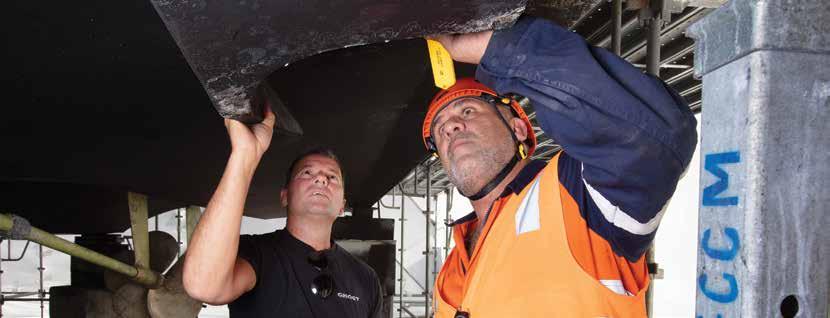
2 minute read
Are the alterations on your vessel above board?
By Simon Anderson
Transitional vessel arrangements offer a more considered and staged approach to updating a vessel, but there are still pitfalls for those not familiar with the standards. Talking to your accredited marine surveyor before getting started can save you effort, time and money in the long run.
Advertisement

Marine survey: Surveyor points out details to vessel owner.
Rob Maccoll
Over 67 per cent of Australia’s domestic commercial vessel fleet meets the definition of an existing—or grandfathered— vessel under Marine Order 503 (Certificates of survey—national law).
Grandfathered vessels must comply with the construction and stability standards that applied to the vessel when it was last surveyed prior to 1 July 2013, but if owners make a change to their grandfathered vessel, it can trigger the vessel to become a transitional vessel.
An existing vessel can lose its grandfathered vessel status and become a transitional vessel in two ways—either it has not held a valid certificate of survey for more than two years, or it has undergone certain types of changes. These changes include:
• adding or upgrading a class
• changes to geographical restrictions or certain operations
• changes to vessel structure, systems, displacement or configuration
• increasing the number of people on board
• carrying dangerous goods.
When we developed the standards and survey requirements for transitional vessels, AMSA set out to create a system to allow existing vessels to make changes in a considered and achievable way, rather than having to meet the requirements of a new vessel all at once.
As a result, the transitional vessel standards are a combination of the National Standard for Commercial Vessels and its predecessor, the Uniform Shipping Laws code. Exactly which transitional standards apply depends on the type of vessel and what change the vessel has undergone.
Transitional vessels must meet transitional standards, irrespective of class or operation type. This may mean that the parts of the vessel—or equipment—while not directly affected by any work done on the vessel may still need altering to meet the transitional requirements. This is where consulting an accredited marine surveyor before you undergo the changes may save you time in the long run.
All vessels entering transitional vessel arrangements must obtain a new certificate of survey. If you aren’t fully aware of what the impact of any changes may be it’s best to check first—you may need to make additional changes before the vessel passes survey and can be issued a new certificate.
Transitional vessels have to do one of three types of survey, depending on the type of change they have undergone.
• Full initial survey in accordance with the three phases of initial survey—plan and stability approval, construction and commissioning.
• Renewal survey to transitional standards, plus limited initial survey for areas of the vessel affected by the change.
• Renewal survey only (in water, out of water, lightship check, shaft survey, periodic load line) to the transitional standards.
Helpful links:
View the existing vessel to transitional vessel flowchart amsa.gov.au/transitional-vesselflowchart
Survey standards for domestic commercial vessels in survey amsa.gov.au/survey-scheme-s
Marine Order 503—Certificates of survey–national law amsa.gov.au/mo503-certificatessurvey-national-law










